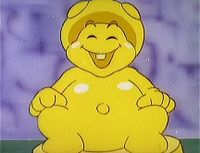Lost Mushroom: Difference between revisions
Apikachu68 (talk | contribs) m (Added citations.) |
Apikachu68 (talk | contribs) (→Names in other languages: Added Chinese, German, and Swedish names.) |
||
| Line 17: | Line 17: | ||
==Names in other languages== | ==Names in other languages== | ||
{{foreign names | {{foreign names | ||
|ChiS=遗失的蘑菇 | |||
|ChiSR=Yíshī De Mógu | |||
|ChiSM=Lost Mushroom | |||
|ChiSC=<ref>[https://www.youtube.com/watch?v=sz0yq34yuxE 失落蘑菇的襲擊者 | 兒童電子遊戲 | 兒童卡通]</ref> | |||
|Fre=Champignon Perdu | |Fre=Champignon Perdu | ||
|FreM=Lost Mushroom | |FreM=Lost Mushroom | ||
|FreC=<ref>[https://www.youtube.com/watch?v=-rEVCZE01J0&list=PLaFoLvczabwZT9mEcsRppZJRvNoW4czwg&index=49 Super Mario Bros 049 Les aventures du champignon perdu]</ref> | |FreC=<ref>[https://www.youtube.com/watch?v=-rEVCZE01J0&list=PLaFoLvczabwZT9mEcsRppZJRvNoW4czwg&index=49 Super Mario Bros 049 Les aventures du champignon perdu]</ref> | ||
|Ger=Verlorenen Pilz | |||
|GerM=Lost Mushroom | |||
|GerC=<ref>[https://www.youtube.com/watch?v=Km83pJ_g0zs&list=PLn0Cm-QzTZcYMFil7DnnbYQJlk7qccB4H&index=72 The Super Mario Bros Super Show! Folge 61 Cyrano de Mario / Die Räuber des verlorenen Pilzes]</ref> | |||
|Ita=Funghetto perduto | |Ita=Funghetto perduto | ||
|ItaM=Lost Little Mushroom/Toad | |ItaM=Lost Little Mushroom/Toad | ||
| Line 28: | Line 35: | ||
|SpaM=Lost Mushroom | |SpaM=Lost Mushroom | ||
|SpaC=<ref>[https://www.youtube.com/watch?v=rgvMm_i2QyE En busca del hongo perdido | Dibujos Para Niños]</ref> | |SpaC=<ref>[https://www.youtube.com/watch?v=rgvMm_i2QyE En busca del hongo perdido | Dibujos Para Niños]</ref> | ||
|Swe=Förloraden Svampen | |||
|SweM=Lost Mushroom | |||
|SweC=<ref>[https://www.youtube.com/watch?v=sB92g-AeYrI&list=PLxFcguXyn2Gq_SVmc3CbdYhMEduSfFfox&index=49 Super Mario Bros Super Show - Episode 49 - Swedish]</ref> | |||
}} | }} | ||
Revision as of 15:17, September 17, 2024
| Lost Mushroom | |
|---|---|

| |
| First appearance | The Super Mario Bros. Super Show! ("Raiders of the Lost Mushroom") (1989) |
The Lost Mushroom is a mysterious, golden statuette of unknown origin that resembles a joyous Mushroom person. For years, most considered it to be legendary, for it has the power to grant the wishes of whoever is in possession of it. A nearly-forgotten ancient treasure, the Lost Mushroom was hidden deep within the Temple of Koopa in Jungleland for several generations.
The Lost Mushroom appears to have been modeled off of the famous Laughing Buddha, or Budai, the image of which has very often been replicated in Buddhist shrines, and statuettes.
History
The Lost Mushroom is only ever seen in The Super Mario Bros. Super Show! episode "Raiders of the Lost Mushroom". According to Kolonel von Koop, the Lost Mushroom was left to him by his great-great grandkoop, although how he got a hold of the Lost Mushroom in the first place and what exactly he used it for remains a mystery. Unbeknownst to Kolonel von Koop, his great-great grandkoop built the Temple of Koopa to hide the Lost Mushroom in.
After being led to the Temple of Koopa by Indiana Joe, Mario, Luigi, Princess Toadstool and Toad brave the dangers within to reach the Lost Mushroom, although they are trapped themselves in the Lost Mushroom's chamber in order to escape from a Fryguy in the process. Mario inadvertently wishes for a trap door out of the chamber, and the Lost Mushroom grants his wish by creating one, which leads to the entrance of the Temple of Koopa. At the entrance, Kolonel von Koop seizes the Lost Mushroom from Mario, and locks his group up in a tree hut with a Shyguy Lion.
Kolonel von Koop then uses the Lost Mushroom to wish for a castle made of solid gold, which appears right before his eyes. Before he and the Koopa Pack can do anything else, Mario recovers the Lost Mushroom from Kolonel von Koop with his plumber's snake.
After defeating Kolonel von Koop and the Koopa Pack, Mario and his friends return to Indiana Joe's home, where Mario uses the Lost Mushroom to wish for the hut to fill up with tons of pasta. Surrounded by spaghetti, Mario comments that he and the Lost Mushroom are going to get along just fine.
Names in other languages
| Language | Name | Meaning | Notes |
|---|---|---|---|
| Chinese (simplified) | 遗失的蘑菇[1] Yíshī De Mógu |
Lost Mushroom | |
| French | Champignon Perdu[2] | Lost Mushroom | |
| German | Verlorenen Pilz[3] | Lost Mushroom | |
| Italian | Funghetto perduto[?] | Lost Little Mushroom/Toad | |
| Portuguese | Cogumelo Perdido[4] | Lost Mushroom | |
| Spanish | Hongo Perdido[5] | Lost Mushroom | |
| Swedish | Förloraden Svampen[6] | Lost Mushroom |
References
- ^ 失落蘑菇的襲擊者 | 兒童電子遊戲 | 兒童卡通
- ^ Super Mario Bros 049 Les aventures du champignon perdu
- ^ The Super Mario Bros Super Show! Folge 61 Cyrano de Mario / Die Räuber des verlorenen Pilzes
- ^ Super Mario Bros. Super Show! - Os Caçadores da Estatueta de Ouro / Mario Cyrano (Dublado)
- ^ En busca del hongo perdido | Dibujos Para Niños
- ^ Super Mario Bros Super Show - Episode 49 - Swedish